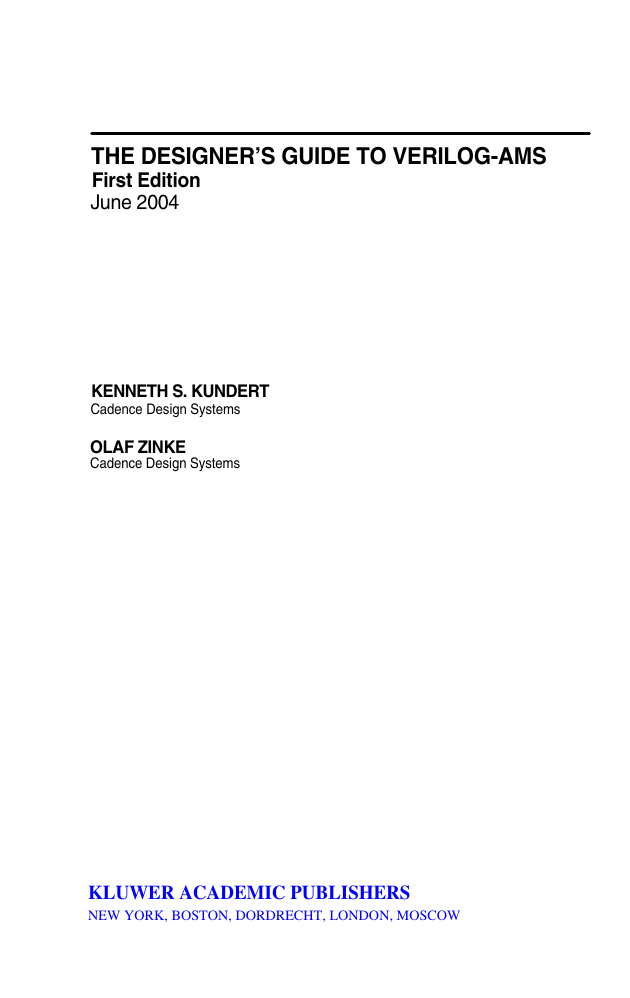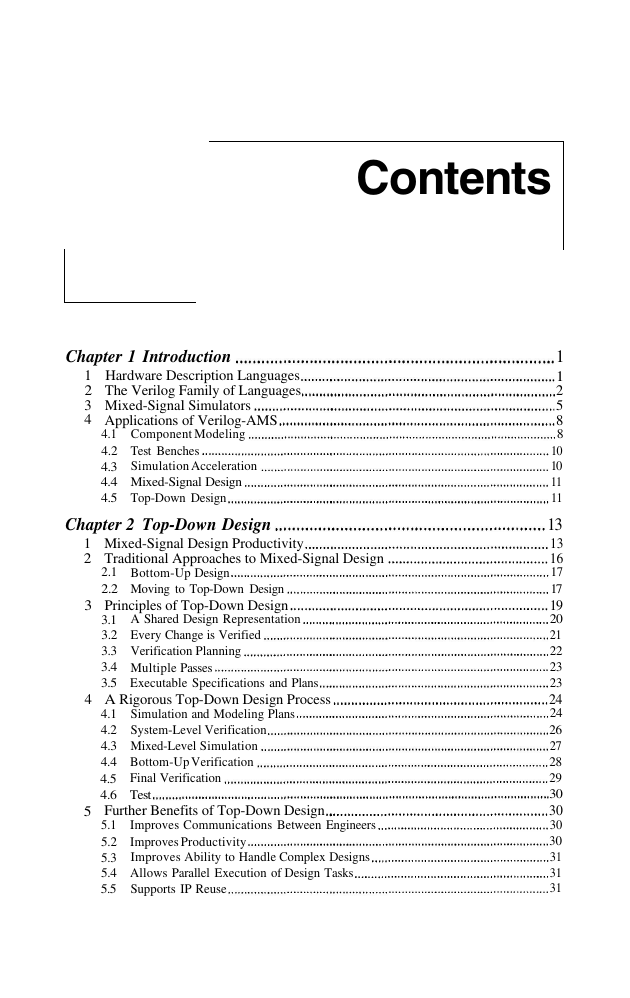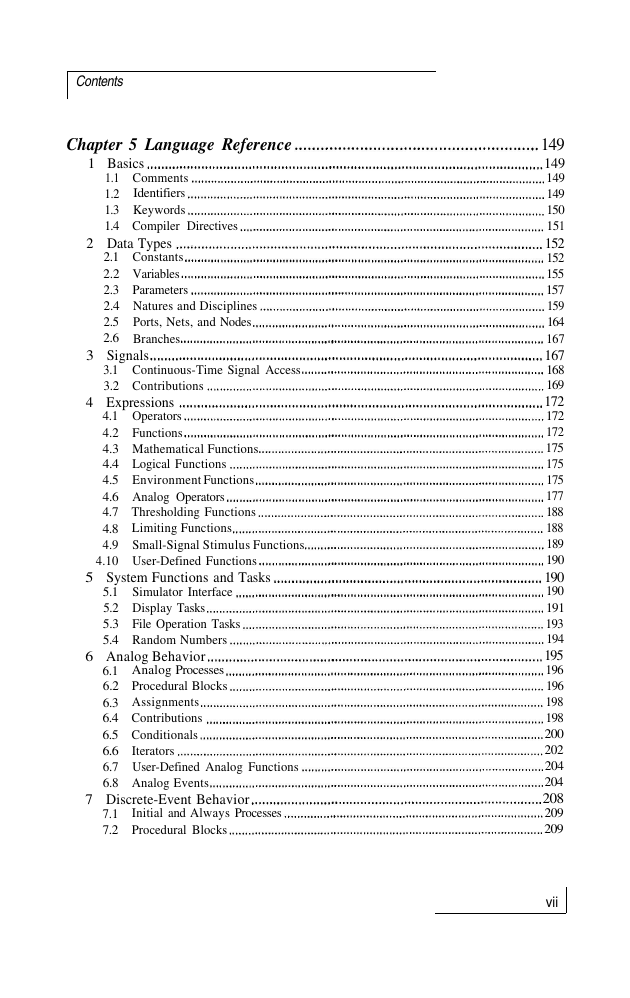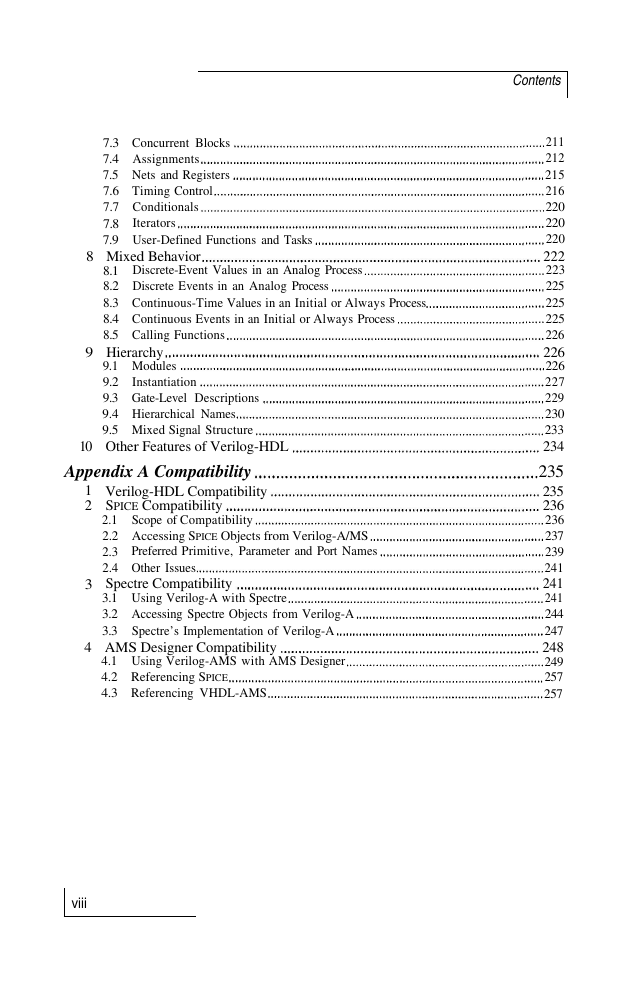THE DESIGNER’S GUIDE TO VERILOG-AMS
�
THE DESIGNER’S GUIDE BOOK SERIES
Consulting Editor
Kenneth S. Kundert
Books in the series:
The Designer’s Guide to Verilog-AMS
ISBN: 1-4020-8044-1
The Designer’s Guide to SPICE AND Spectre®
ISBN: 0-7923-9571-9
�
THE DESIGNER’S GUIDE TO VERILOG-AMS
First Edition
June 2004
KENNETH S. KUNDERT
Cadence Design Systems
OLAF ZINKE
Cadence Design Systems
KLUWER ACADEMIC PUBLISHERS
NEW YORK, BOSTON, DORDRECHT, LONDON, MOSCOW
�
eBook ISBN:
Print ISBN:
1-4020-8045-X
1-4020-8044-1
©2004 Kluwer Academic Publishers
New York, Boston, Dordrecht, London, Moscow
Print ©2004 Kluwer Academic Publishers
Boston
All rights reserved
No part of this eBook may be reproduced or transmitted in any form or by any means, electronic,
mechanical, recording, or otherwise, without written consent from the Publisher
Created in the United States of America
Visit Kluwer Online at:
and Kluwer's eBookstore at:
http://kluweronline.com
http://ebooks.kluweronline.com
�
Contents
Chapter 1 Introduction
1
2
3
4
Hardware Description Languages
The Verilog Family of Languages
Mixed-Signal Simulators
Applications of Verilog-AMS
4.1
4.2
4.3
4.4
4.5
Component Modeling
Test Benches
Simulation Acceleration
Mixed-Signal Design
Top-Down Design
Chapter 2 Top-Down Design
1
2
3
4
5
A Shared Design Representation
Every Change is Verified
Verification Planning
Multiple Passes
Executable Specifications and Plans
Simulation and Modeling Plans
System-Level Verification
Mixed-Level Simulation
Bottom-Up Verification
Final Verification
Test
Mixed-Signal Design Productivity
Traditional Approaches to Mixed-Signal Design
2.1
Bottom-Up Design
Moving to Top-Down Design
2.2
Principles of Top-Down Design
3.1
3.2
3.3
3.4
3.5
A Rigorous Top-Down Design Process
4.1
4.2
4.3
4.4
4.5
4.6
Further Benefits of Top-Down Design
5.1
5.2
5.3
5.4
5.5
Improves Communications Between Engineers
Improves Productivity
Improves Ability to Handle Complex Designs
Allows Parallel Execution of Design Tasks
Supports IP Reuse
1
1
2
5
8
8
10
10
11
11
13
13
16
17
17
19
20
21
22
23
23
24
24
26
27
28
29
30
30
30
30
31
31
31
�
Contents
32
35
35
39
40
41
41
46
50
51
54
58
60
63
65
67
69
71
73
73
77
79
80
84
87
88
94
96
99
99
100
100
109
111
113
115
118
121
122
123
128
131
6 Final Words on Top-Down Design
Chapter 3 Analog Modeling
1
2
3
4
5
6
7
8
9
10
11
12
13
14
Conservative Systems
Natures and Disciplines
Junction Diode with Series Resistor
Probes and Sources
Series and Parallel RLC
Capacitor
Inductor
Voltage and Current Sources
Resistor
1.1
1.2
1.3
A Simple Circuit
2.1
Motor
3.1
Junction Diode
4.1
4.2
4.3
Resistive Port
Relay
6.1
6.2
6.3
Voltage-Controlled Oscillator
Periodic Sample and Hold
8.1
Time Interval Measurement
Analog to Digital Converter
Digital to Analog Converter
Lossy Inductor
Tolerances
Elements of Style
Non-Ideal Relay
Ideal Mechanical Stop
Ideal Diode
Smoothing the Output
Chapter 4 Mixed-Signal Modeling
Language Basics
Integers and Reals
Mixed Signal Models
Modeling Discrete Behavior
2.1
2.2
Modeling Mixed-Signal Behavior
3.1
3.2
3.3
Structural Verilog-AMS
4.1
4.2
4.3
4.4
Connecting Analog and Digital
Discipline Resolution
Automatic Connect Module Insertion
Modeling Connect Modules
Analog and Digital Contexts
From Digital to Analog
From Analog to Digital
1
2
3
4
vi
�
Contents
Chapter 5 Language Reference
1 Basics
Comments
Identifiers
Keywords
Compiler Directives
Constants
Variables
Parameters
Natures and Disciplines
Ports, Nets, and Nodes
Branches
1.1
1.2
1.3
1.4
Data Types
2.1
2.2
2.3
2.4
2.5
2.6
Signals
3.1
3.2
Expressions
Operators
4.1
Functions
4.2
Mathematical Functions
4.3
Logical Functions
4.4
Environment Functions
4.5
Analog Operators
4.6
Thresholding Functions
4.7
Limiting Functions
4.8
Small-Signal Stimulus Functions
4.9
4.10
User-Defined Functions
Continuous-Time Signal Access
Contributions
2
3
4
5
6
7
Simulator Interface
Display Tasks
File Operation Tasks
Random Numbers
System Functions and Tasks
5.1
5.2
5.3
5.4
Analog Behavior
6.1
6.2
6.3
6.4
6.5
6.6
6.7
6.8
Discrete-Event Behavior
7.1
7.2
Analog Processes
Procedural Blocks
Assignments
Contributions
Conditionals
Iterators
User-Defined Analog Functions
Analog Events
Initial and Always Processes
Procedural Blocks
149
149
149
149
150
151
152
152
155
157
159
164
167
167
168
169
172
172
172
175
175
175
177
188
188
189
190
190
190
191
193
194
195
196
196
198
198
200
202
204
204
208
209
209
vii
�
Contents
211
212
215
216
220
220
220
222
223
225
225
225
226
226
226
227
229
230
233
234
235
235
236
236
237
239
241
241
241
244
247
248
249
257
257
Concurrent Blocks
Assignments
Nets and Registers
Timing Control
Conditionals
Iterators
User-Defined Functions and Tasks
7.3
7.4
7.5
7.6
7.7
7.8
7.9
Mixed Behavior
8.1
8.2
8.3
8.4
8.5
Hierarchy
9.1
9.2
9.3
9.4
9.5
Other Features of Verilog-HDL
Modules
Instantiation
Gate-Level Descriptions
Hierarchical Names
Mixed Signal Structure
Discrete-Event Values in an Analog Process
Discrete Events in an Analog Process
Continuous-Time Values in an Initial or Always Process
Continuous Events in an Initial or Always Process
Calling Functions
Appendix A Compatibility
8
9
10
1
2
3
4
viii
Scope of Compatibility
Accessing SPICE Objects from Verilog-A/MS
Preferred Primitive, Parameter and Port Names
Other Issues
Verilog-HDL Compatibility
SPICE Compatibility
2.1
2.2
2.3
2.4
Spectre Compatibility
3.1
3.2
3.3
AMS Designer Compatibility
4.1
4.2
4.3
Using Verilog-A with Spectre
Accessing Spectre Objects from Verilog-A
Spectre’s Implementation of Verilog-A
Using Verilog-AMS with AMS Designer
Referencing SPICE
Referencing VHDL-AMS
�
















 2023年江西萍乡中考道德与法治真题及答案.doc
2023年江西萍乡中考道德与法治真题及答案.doc 2012年重庆南川中考生物真题及答案.doc
2012年重庆南川中考生物真题及答案.doc 2013年江西师范大学地理学综合及文艺理论基础考研真题.doc
2013年江西师范大学地理学综合及文艺理论基础考研真题.doc 2020年四川甘孜小升初语文真题及答案I卷.doc
2020年四川甘孜小升初语文真题及答案I卷.doc 2020年注册岩土工程师专业基础考试真题及答案.doc
2020年注册岩土工程师专业基础考试真题及答案.doc 2023-2024学年福建省厦门市九年级上学期数学月考试题及答案.doc
2023-2024学年福建省厦门市九年级上学期数学月考试题及答案.doc 2021-2022学年辽宁省沈阳市大东区九年级上学期语文期末试题及答案.doc
2021-2022学年辽宁省沈阳市大东区九年级上学期语文期末试题及答案.doc 2022-2023学年北京东城区初三第一学期物理期末试卷及答案.doc
2022-2023学年北京东城区初三第一学期物理期末试卷及答案.doc 2018上半年江西教师资格初中地理学科知识与教学能力真题及答案.doc
2018上半年江西教师资格初中地理学科知识与教学能力真题及答案.doc 2012年河北国家公务员申论考试真题及答案-省级.doc
2012年河北国家公务员申论考试真题及答案-省级.doc 2020-2021学年江苏省扬州市江都区邵樊片九年级上学期数学第一次质量检测试题及答案.doc
2020-2021学年江苏省扬州市江都区邵樊片九年级上学期数学第一次质量检测试题及答案.doc 2022下半年黑龙江教师资格证中学综合素质真题及答案.doc
2022下半年黑龙江教师资格证中学综合素质真题及答案.doc